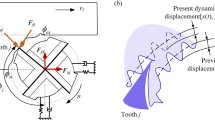Abstract
Chatter is a kind of self-excited, unstable vibration in almost all machining processes. Existing studies have been focusing on the pre-chatter stage, developing various techniques to detect, predict, and suppress chatter. In real applications, chatter will inevitably happen under certain cutting conditions, with generating chatter marks on the workpiece surface. Additional operations are required to remove chatter marks before the finish machining. It is noted that chatter marks will easily induce chatter again, resulting in worse surface quality. This paper quantitatively analyzes the effects of chatter marks on the stability of the process by modeling chatter marks with a periodically modulated depth of cut. Stability lobes show that the existence of chatter marks greatly reduces the stability limit. Furthermore, chatter mark removal using spindle speed variation (SSV) is proposed. Extended high-order full-discretization method using Lagrange interpolation is developed to analyze the effect of SSV on chatter marks removal. It is shown that SSV can remarkably improve the stability limit even with chatter marks. Finally, machining experiments of thin-walled discs are conducted to verify the deterioration effect of chatter marks on the stability limit and show that chatter marks can be effectively removed by the SSV.
Similar content being viewed by others
References
Quintana G, Ciurana J (2011) Chatter in machining processes: a review. Int J Mach Tools Manuf 25(5):363–376
Siddhpura M, Paurobally R (2012) A review of chatter vibration research in turning. Int J Mach Tools Manuf 61(10):27–47
Chen CK, Tsao YM (2006) A stability analysis of regenerative chatter in turning process without using tailstock. Int J Adv Manuf Technol 29(7):648–654
Siddhpura M, Siddhpura A, Paurobally R (2017) Chatter stability prediction for a flexible tool-workpiece system in a turning process. Int J Adv Manuf Technol 1–16. doi:10.1007/s00170-017-0208-2
Frumuşanu GR, Epureanu A, Constantin IC (2012) Method for early detection of the regenerative instability in turning. Int J Adv Manuf Technol 58(1):29–43
Altintas Y (2000) Manufacturing automation: principles of metal cutting and machine tool vibrations. Cambridge, New York
Wan M, Ma YC, Feng J, Zhang WH (2016) Study of static and dynamic ploughing mechanisms by establishing generalized model with static milling forces. Int J Mech Sci 114:120–131
Wan M, Ma YC, Zhang WH, Yang Y (2015) Study on the construction mechanism of stability lobes in milling process with multiple modes. Int J Adv Manuf Technol 79:589–603
Sekar M, Srinivas J, Kotaiah KR, Yang SH (2009) Stability analysis of turning process with tailstock-supported workpiece. Int J Adv Manuf Technol 43(9):862–871
Otto A, Khasawneh FA, Radons G (2015) Position-dependent stability analysis of turning with tool and workpiece compliance. Int J Adv Manuf Technol 79(9):1453–1463
Insperger T, Stépán G, Turi J (2008) On the higher-order semi-discretizations for periodic delayed systems. J Sound Vib 313(1):334–341
Ding Y, Zhu LM, Zhang XJ, Ding H (2010) A full-discretization method for prediction of milling stability. Int J Mach Tools Manuf 50(5):502–509
Urbikain G, Fernández A, de Lacalle LL, Gutiérrez ME (2013) Stability lobes for general turning operations with slender tools in the tangential direction. Int J Mach Tools Manuf 67(4):35–44
Sun YX, Xiong ZH (2016) An optimal weighted wavelet packet entropy method with application to real-time chatter detection. IEEE/ASME Trans Mechatron 21(4):2004–2014
Rafal R, Pawel L, Krzysztof K, Bogdan K, Jerzy W (2015) Chatter identification methods on the basis of time series measured during titanium superalloy milling. Int J Mech Sci 99(8):196–207
Delio T, Tlusty J, Smith S (1992) Use of audio signals for chatter detection and control. J Manuf Sci Eng 114(2):146–157
Turner S, Merdol S, Altintas Y, Ridgway K (2007) Modelling of the stability of variable helix end mills. Int J Mach Tools Manuf 47(9):1410–1416
Urbikain G, Olvera D, de Lacalle LL, Elías-Zúñiga A (2016) Spindle speed variation technique in turning operations: modeling and real implementation. J Sound Vib 383:384–396
Tarng YS, Hseih YW, Li TC (1996) Automatic selection of spindle speed for suppression of regenerative chatter in turning. Int J Adv Manuf Technol 11(1):12–17
Pour DS, Behbahani S (2016) Semi-active fuzzy control of machine tool chatter vibration using smart MR dampers. Int J Adv Manuf Technol 83(1):1–8
Matsubara A, Maeda M, Yamaji I (2014) Vibration suppression of boring bar by piezoelectric actuators and LR circuit. CIRP Ann Manuf Technol 63(1):373–376
Yeh LJ, Lai GJ (1995) A study of the monitoring and suppression system for turning slender workpieces. Proc Inst Mech Eng B J Eng Manuf 209(3):227–236
Insperger T, Stépán G (2004) Updated semi-discretization method for periodic delay-differential equations with discrete delay. Int J Numer Methods Eng 61(1):117–141
Liu Y, Fischer A, Eberhard P, Wu B (2015) A high-order full-discretization method using Hermite interpolation for periodic time-delayed differential equations. Acta Mech Sinica 31(3):406–415
Sun YX, Xiong ZH (2017) High-order full-discretization method using Lagrange interpolation for stability analysis of turning processes with stiffness variation. J Sound Vib 386:50–64
Stoferle T, Grab H (1972) Vermeiden von Ratterschwingungen durch Periodische Drehzahlanderung. Werkst Betrieb 105:727–730
Insperger T, Stépán G (2011) Semi-discretization for time-delay systems: stability and engineering applications. Springer-Verlag, New York
de Canniere J, van Brussel H, van Bogaert J (1981) A contribution to the mathematical analysis of variable spindle speed machining. Appl Math Model 5(3):158–164
Al-Regib E, Ni J, Lee SH (2003) Programming spindle speed variation for machine tool chatter suppression. Int J Mach Tools Manuf 43(12):1229–1240
Insperger T, Stépán G (2004) Stability analysis of turning with periodic spindle speed modulation via semi-discretization. J Vib Control 10(12):1835–1855
Meng HF, Kang Y, Chen Z, Zhao YB, Liu GP (2015) Stability analysis and stabilization of a class of cutting systems with chatter suppression. IEEE/ASME Trans Mechatron 20(2):991–996
Author information
Authors and Affiliations
Corresponding author
Rights and permissions
About this article
Cite this article
Sun, Y., Xiong, Z. Modeling, analysis, and removal of chatter marks in flexible turning. Int J Adv Manuf Technol 93, 4187–4196 (2017). https://doi.org/10.1007/s00170-017-0856-2
Received:
Accepted:
Published:
Issue Date:
DOI: https://doi.org/10.1007/s00170-017-0856-2




